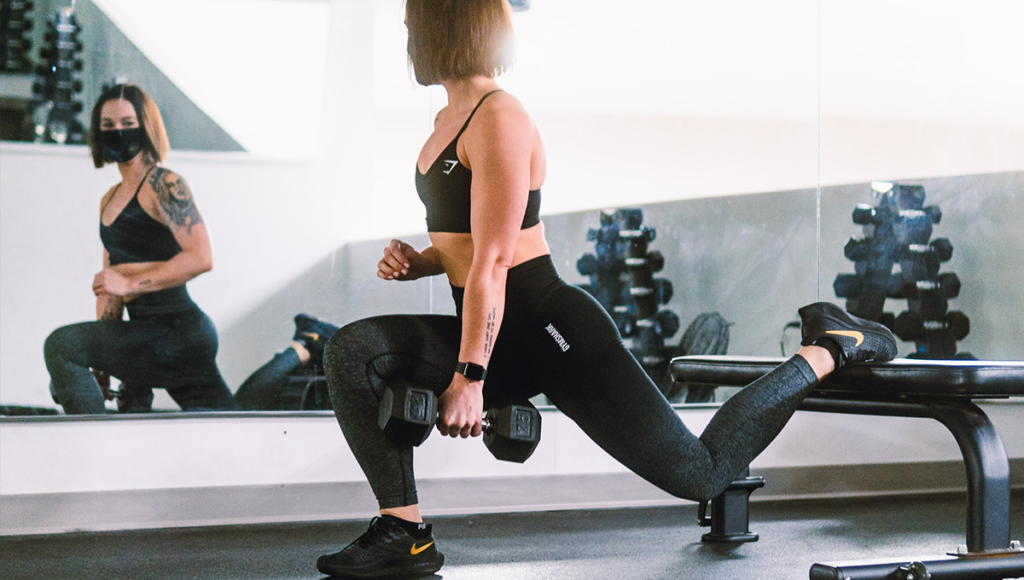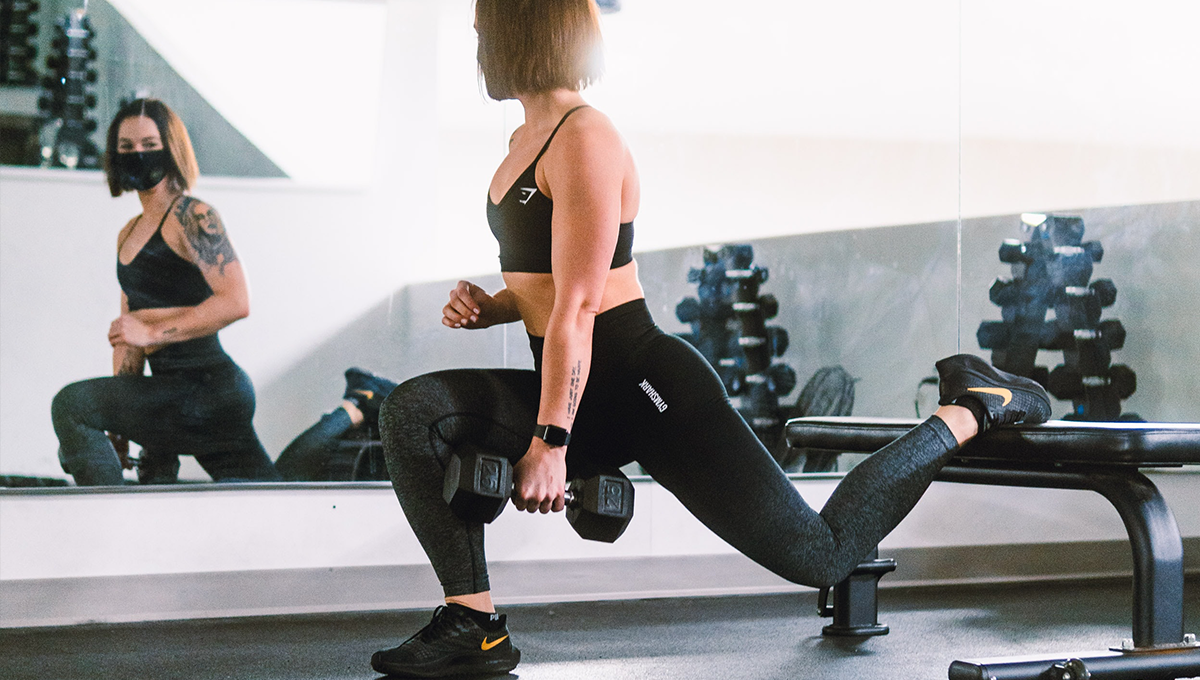The Bulgarian Split Squat is one slightly obscure yet highly underrated fitness exercise. For those who know it, it can be regarded as the king of single-leg exercises for its ability to build control, balance, power, and strength.
What is the Bulgarian Split Squat?
The Bulgarian Split Squat is a squat variation where one leg is elevated on a surface and other performs a squat, receiving most of the load.
Because of this split position, this single-leg unilateral exercise targets the quadricep muscles, glutes, and hamstrings like no other leg exercise.
It is an exercise recommended for intermediate to advance level athletes who have more control and body-awareness, but beginners can also perform Bulgarian Split Squats on a lower elevated surface without weights to develop these traits.
Benefits of doing Bulgarian Split Squats
There are many benefits to adding Bulgarian Split Squats into your training; not only do you strengthen all muscles targeted with a standard squat, but also increase your single leg strength and gain balance and control through the challenge this exercise presents.
As a unilateral movement, the Bulgarian Split Squat is great for spotting and addressing any imbalances you might have in your lower body. This will then carry over to compound lifts, where you’ll become less likely to compensate with your stronger side.
As well as being a great exercise to build muscle and strength, the Bulgarian Split Squat can improve your ankle and hip mobility when practiced regularly. Additionally, if performed with weights, it’ll increase your core strength and general stability, reinforcing your midline.
Building strength with the Bulgarian Split Squat will carry over to other forms of squat and can help you get over strength plateaus.
Bulgarian Split Squat form
You’ll only need a stable elevated surface to start off with. As you progress with the exercise, you might want to include dumbbells, kettlebells or even a barbell. The correct form to perform a Bulgarian Split Squat is as follows:
- Start by stepping your rear foot back onto an elevated surface, placing the top of your foot on top of the bench, plates or whatever you’re using as a step. Your front foot should be about two feet in front of your bench.
- The bench height in the Bulgarian Split Squat should be small as your start out – around 4” should be fine – and can be increased as your hip flexibility, strength and balance improve. A standard height is around 8-10”.
- With your whole body pointing straight ahead and keeping your core engaged and your torso upright, descend under control until your back knee touches or comes close to touching the ground. The majority of the weight should be kept over the front foot (around 80%), with the additional weight on the rear foot (around 20%).
- Your front knee should tail your front toes; make sure it’s not caving in to the sides and doesn’t drift too far in front of your toes. Also ensure the descend is controlled; ideally, it’ll take you a second or two to reach the bottom of the exercise.
- You can decide whether to perform the Bulgarian Split Squat with external weights, all of the variations are expanded on below.
- To stand back up, drive through the heel on your front foot and come back to a standing position. Continue to make sure your torso is straight and you keep a neutral spine throughout the exercise.
- Change legs after a handful of reps and repeat.
How to do a Bulgarian Split Squat
Watch this video for a visual demonstration of the Bulgarian Split Squat.
Common faults
- Lifting the front heel: make sure your front foot is flat on the floor and your heel stays grounded throughout the exercise. Adjust the position of your front leg in regard to the elevated surface to fix this fault.
- Driving through the back leg: this exercise should target your front leg mostly, with the back leg only there to offer support and balance. Make sure you are consciously lifting the majority of your weight with the front leg.
- Tipping forward: keep the angle of your upper body upright thought the movement. If you’re tipping forward you might have to adjust your leg positioning or reduce the weight you’re trying to lift.
- Using a surface that’s too high: there’s no need to elevate your back foot too far up, and your technique is likely to suffer if you do.
Bulgarian Split Squat Muscles worked
The Bulgarian Split Squat is a lower body exercise that primarily targets your hamstrings, quadriceps, glutes, abductor muscles, and calves.
Secondarily, this exercise taxes also your abdominal muscles and spinal erectors.
Depending on where you place your feet, as well as what weight you use and how you choose to hold it, the Bulgarian Split Squat will target slightly different muscles. Standing close to your elevated surface will emphasise your quads (although you should be aware of your knees), while standing further away will tax your hip flexors more heavily.
Holding weights above your chest as you would with an overhead or back- or front-loaded Bulgarian Split Squat will also increase the strain in your core muscles.
 Source: Matthew Sichkaruk on Unsplash
Source: Matthew Sichkaruk on UnsplashBulgarian Split Squat variations
While the leg positioning in the Bulgarian Split Squat is mostly the same, there are multiple ways you could hold the weights to vary the exercise. You can either:
- Hold a pair of dumbbells by your sides
- Hold a barbell, dumbbell or kettlebell by your chest (front loaded Bulgarian Split Squat)
- Hold a barbell behind your back (back loaded Bulgarian Split Squat)
- Hold a weight overhead
Below we’ll go over all these variations and their benefits.
Two Dumbbell Bulgarian Split Squat
Also known as a suitcase Bulgarian Split Squat, this dumbbell variation adds weight on both your arms. Performing the exercise holding two dumbbells to your sides ensures muscular balance on both sides of the body.
The suitcase Bulgarian Split Squat can also be performed with kettlebells or any other weight, so long as you hold it by your sides.
Front loaded Bulgarian Split Squat
For this variation, you’d hold a weight by your chest with both hands as you would do for a Goblet Squat. You can also use a barbell and hold it crossed-armed or use the front rack position.
Adding this weight can help with stability and will place a bigger emphasis on your core muscles than a standard bodyweight Bulgarian Split Squat. Make sure your back is not rounded by tightening up your core.
Back loaded Bulgarian Split Squat
To add more resistance to the exercise load a barbell onto your shoulders and complete the same movement. You’ll have to be careful to keep your torso upright throughout the exercise for this variation, as the added weight on your back might make you prone to tilting your chest forward.
Overhead Bulgarian Split Squat
This variation of the exercise where the athlete holds a weight overhead places a greater emphasis on the midline than any other variation. The core strength required to stabilise an overhead Bulgarian Split Squat is unmatched.
Because of this, this variation will probably not allow you to lift the heaviest weights but is a very advanced exercise and can be included in your full-body training.
Bulgarian Split Squat workouts
Try the following workouts to include the Bulgarian Split Squat in your training regime.
Workout 1
| 4 rounds (2 rounds each side) :45 work / :15 rest – Bulgarian Split Squat – Single-Leg Deadlift – Single-Leg Step Up – Side Lunge – Single-Leg Hip Thrust 1 minute total rest between rounds |
Workout by @heatherblackfit
Workout 2
| AMRAP in 22 minutes From 0:00-10:00, AMRAP of: – 35 Double-Unders – 15/15 Bulgarian Split Squats – 5 Devil Presses (2×50/35 lb) Rest 2 minutes From 12:00-22:00, AMRAP of: – 35 Double-Unders – 15/15 Bulgarian Split Squats – 5 Devil Presses (2×50/35 lb) |
Workout by NCFit.
Workout 3
| 5 Rounds for Time: – 20 Air Squats – 20 Alternating Lunges – 10/10 Bulgarian Split Squats – 10 Squat Jumps |
Workout by CrossFit Stimulus.
Read more: Rep Ranges Explained: Learn How to Boost Your Strength and Hypertrophy
Expand Your Knowledge
Learn what type of squat is best for you depending on your abilities or try these excellent variations:
| Landmine Squat |
| Jefferson Squat |
| Hack Squat |
| Front Squat |
| Prisoner Squats |
| Zercher Squat |
| Cossack Squat |
| Box Squat |
Read more: 6 Back Squat Benefits That Will Make You Want to Grab a Barbell Straight Away
Image Sources
- bulgarian-split-squat-how-to: Matthew Sichkaruk on Unsplash
